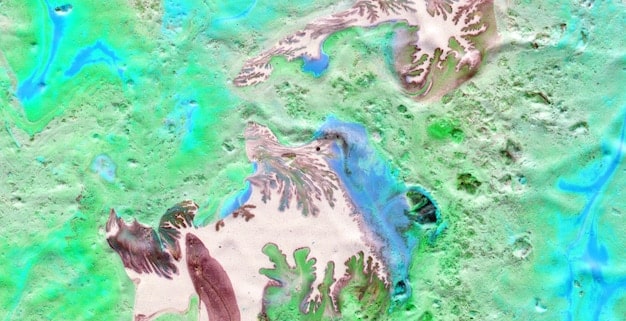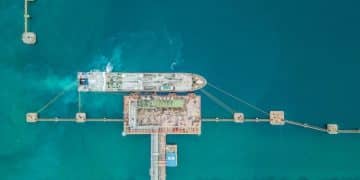US State vs. Federal Marine Protected Areas: Key Differences Unveiled

US State and Federal Marine Protected Areas (MPAs) are distinct conservation tools, with state MPAs typically managing nearshore waters and federal MPAs safeguarding offshore, larger ecosystems, each operating under separate legislative frameworks and management objectives.
Understanding the intricate relationship between human activities and marine ecosystems is paramount for effective conservation. As stewards of our blue planet, recognizing the nuanced differences between protective measures is crucial. This article delves into What are the Key Differences Between US State and Federal Marine Protected Areas, a topic vital for anyone interested in marine conservation, policy, or simply appreciating the delicate balance of ocean life.
Understanding the Concept of Marine Protected Areas
Marine Protected Areas (MPAs) are designated ocean spaces established to conserve marine biodiversity, natural and cultural resources, and ecosystem services. These areas range from small, specific sites to vast stretches of ocean, each with unique management goals. The overarching aim is to safeguard marine life and habitats from various anthropogenic pressures, promoting recovery and resilience within fragile ecosystems. While the concept of MPAs is globally recognized, their implementation and governance vary significantly, particularly between national and sub-national jurisdictions.
Historically, the idea of setting aside areas for conservation on land has been well-established, leading to national parks and wildlife refuges. However, applying similar principles to the marine environment presented unique challenges due to the fluid nature of the ocean, the mobility of marine species, and complex jurisdictional boundaries. Early MPAs often focused on single species protection or specific habitats, but over time, the understanding evolved to encompass a broader ecosystem-based management approach, recognizing the interconnectedness of marine life and its environment.
The Global Context of MPAs
Globally, MPAs are diverse, reflecting the varied ecological, social, and economic contexts in which they operate. International agreements and initiatives, such as the Convention on Biological Diversity (CBD), have encouraged countries to establish networks of MPAs to achieve biodiversity conservation targets. These global efforts emphasize the importance of robust scientific research, effective enforcement, and community engagement to ensure the long-term success of MPAs. The lessons learned from international experiences often inform national and sub-national MPA strategies, highlighting best practices and common challenges in marine conservation.
- MPAs are vital for maintaining ecosystem health and resilience.
- They provide safe havens for threatened species to recover.
- MPAs can enhance fisheries by protecting breeding grounds.
- They offer sites for scientific research and education.
The success of an MPA depends not just on its designation, but on effective management, surveillance, and community support. Without these pillars, even the most ambitious conservation goals can fall short. The designation of an MPA is merely the first step; the sustained effort to protect and manage it is what truly makes a difference.
In conclusion, MPAs represent a critical tool in the global effort to conserve our oceans. Their effectiveness hinges on a clear understanding of their objectives, the ecological context, and the regulatory frameworks governing them. As we explore the differences between state and federal MPAs in the US, it becomes clear that these distinctions are crucial for comprehending the complete picture of marine conservation efforts.
Jurisdictional Frameworks: State vs. Federal Authority
The primary distinction between US State and Federal Marine Protected Areas lies in their jurisdictional frameworks. The United States has a complex system of intertwined authorities regarding its coastal and ocean resources, stemming from a combination of historical precedents, statutory laws, and international agreements. This division of power means that coastal states typically manage marine areas closer to their shores, while the federal government oversees activities in offshore waters, extending to the exclusive economic zone (EEZ).
State jurisdiction generally covers internal waters and the territorial sea, extending three nautical miles (approximately 3.45 statute miles) from the coastline. However, there are exceptions; Texas and Florida, for instance, have historical claims that extend their jurisdiction to nine nautical miles in the Gulf of Mexico. Within these state waters, individual state conservation agencies and commissions have the authority to establish and manage MPAs, enacting their own specific regulations and enforcement mechanisms. This allows for tailored management approaches that cater to unique regional ecological characteristics and local community needs.
Federal Authority in Offshore Waters
Beyond the state marine boundaries, federal jurisdiction takes over. This vast area includes the Outer Continental Shelf (OCS) and extends out to the 200-nautical-mile limit of the Exclusive Economic Zone (EEZ). Numerous federal agencies, such as the National Oceanic and Atmospheric Administration (NOAA), the U.S. Fish and Wildlife Service (USFWS), and the National Park Service (NPS), are involved in the establishment and management of federal MPAs. These federal designations often encompass larger, more ecologically significant areas that transcend state boundaries, requiring a broader, national perspective on conservation.
- State MPAs are managed by individual states, primarily within 3 nautical miles (or 9 for TX/FL).
- Federal MPAs are overseen by federal agencies, extending from state limits to 200 nautical miles (EEZ).
- Jurisdictional lines dictate the specific laws and regulations that apply.
- Understanding these boundaries is crucial for effective compliance and enforcement.
The differences in authority also translate into distinct legislative mandates and funding mechanisms. State MPAs often derive their power from state-specific environmental protection acts and may be funded through state budgets or local initiatives. Federal MPAs, conversely, are typically established under federal laws like the National Marine Sanctuaries Act, the Magnuson-Stevens Fishery Conservation and Management Act, or the National Parks Organic Act, and funded through federal appropriations.
The complexity of these overlapping jurisdictions can sometimes lead to coordination challenges, but also offers opportunities for collaborative management. Many successful MPA initiatives involve partnerships between state and federal agencies, local communities, and non-governmental organizations, demonstrating a shared commitment to marine conservation despite differing jurisdictional lines. This multi-level governance approach, while intricate, is designed to provide comprehensive protection across the diverse marine environments of the US.
Management Objectives and Conservation Focus
The specific management objectives and conservation focus often diverge significantly between US State and Federal Marine Protected Areas, reflecting their distinct jurisdictional remits and the unique characteristics of the areas they aim to protect. State MPAs frequently prioritize concerns that are more immediate and localized, often addressing issues directly impacting coastal communities or specific nearshore habitats. Their focus might include protecting recreational fishing grounds, preserving local aquaculture sites, conserving critical nursery habitats for state-managed species, or safeguarding cultural heritage sites accessible from the shore.
For instance, a state MPA might be established to protect a specific kelp forest ecosystem known to support local fisheries, or to manage a sensitive estuary that serves as a vital bird nesting area and maintains water quality for nearby communities. The objectives are often more directly tied to the socio-economic and ecological needs of the adjacent state, allowing for rapid and adaptive management responses to local environmental changes or threats. This localized focus enables states to implement highly specific regulations, such as seasonal fishing closures or restrictions on particular gear types, tailored to their unique marine environments.

Broad Ecological and National Priorities in Federal MPAs
Conversely, Federal MPAs typically address broader ecological and national conservation priorities. Given their management of offshore and often larger areas, these MPAs are designed to protect vast ecosystems, migratory pathways for marine mammals and large pelagic fish, deep-sea habitats, and areas of significant scientific or national cultural importance. Their objectives often include conserving biodiversity on a grander scale, mitigating impacts from activities like offshore energy development or commercial shipping, and conducting research on climate change effects in open ocean environments.
- State MPAs usually focus on localized concerns: recreational fishing, aquaculture, nearshore habitats.
- Federal MPAs prioritize broad ecological issues: biodiversity, migratory routes, deep-sea environments.
- Management objectives reflect differing scales and primary beneficiaries.
- Tailored regulations are common in both, but respond to different sets of stakeholders and challenges.
For example, a National Marine Sanctuary might be designated to protect unique deep-sea coral communities, a World War II shipwreck, or a critical feeding ground for endangered whales spanning multiple states’ coastal waters. The management plans for federal MPAs often involve comprehensive assessments of large marine ecosystems, considering cumulative impacts from various sources and aiming for long-term ecological resilience. Federal regulations in these areas might involve broad prohibitions on certain types of fishing, restrictions on vessel traffic, or limitations on resource extraction activities.
While both levels of government aim for conservation, their specific missions result in different emphases. State MPAs often have a more direct connection to immediate community benefits and local resource management, whereas federal MPAs tend to concentrate on large-scale ecosystem functions, national heritage, and scientific research that benefits the entire nation. This complementary approach ensures that conservation efforts are addressed from both a localized and a broader ecosystem perspective, covering a wide range of marine environments and conservation needs.
Permitted Activities and Restrictions
The spectrum of permitted activities and associated restrictions within Marine Protected Areas varies significantly between state and federal designations, a direct consequence of their differing management objectives and jurisdictional scopes. These variations are crucial for stakeholders, including fishers, recreational users, and researchers, as they dictate what can and cannot be done within these conservation zones. Generally, state MPAs, being closer to shore and often interacting more directly with local communities, tend to have a wider array of permitted activities, albeit with specific local restrictions.
Within state marine waters, MPAs might allow various forms of recreational fishing, limited commercial fishing, diving, boating, and other water sports, along with scientific research. However, these activities are typically subject to detailed regulations designed to minimize adverse impacts. For example, a state MPA might impose size limits, catch restrictions, seasonal closures for specific species, or prohibitions on particular fishing gear (e.g., no trawling near sensitive habitats). Some state MPAs might be designated as “no-take” zones for certain species, while still allowing other types of fishing or recreational use. The restrictions are often finely tuned to address specific local conservation needs and human uses.
Federal Restrictions and No-Take Zones
Federal MPAs, especially those designated as National Marine Sanctuaries or parts of the National Park System, often implement more comprehensive restrictions, sometimes including extensive “no-take” zones or areas with highly limited access. This is particularly true for offshore areas that harbor unique or highly sensitive ecosystems, critical spawning grounds, or areas of significant historical/cultural importance that require minimal human disturbance. Activities such as oil and gas exploration, sand and gravel mining, and certain types of commercial fishing may be prohibited across wide swaths of federal MPAs.
- State MPAs often allow diverse activities with tailored local restrictions (e.g., gear limits, seasonal closures).
- Federal MPAs may impose broader prohibitions, including extensive “no-take” zones for strict conservation.
- Restrictions reflect the scale of the MPA and its primary conservation goals.
- Understanding specific regulations is paramount for all marine users.
For instance, some federal MPAs, like portions of the Papahānaumokuākea Marine National Monument in the Pacific, are almost entirely “no-take” and have very limited public access, focusing primarily on biodiversity preservation and scientific research. Other federal MPAs might have tiered restrictions, allowing various uses in some zones while strictly protecting core areas. While passive recreation like boating or wildlife viewing is often permitted in many federal MPAs, activities that could directly impact the ecosystem, such as anchoring on corals or unauthorized research, are usually strictly regulated or prohibited.
The rationale behind these restrictions is rooted in the specific conservation goals of each MPA. Where a state MPA might balance conservation with local economic uses, a federal MPA might prioritize the long-term health of an entire ecosystem over short-term resource exploitation. Navigating these differing sets of regulations requires an awareness of the specific MPA’s designation and its governing body, ensuring compliance and contributing to the effective protection of these valuable marine resources for future generations. These varying levels of restrictions underscore the mosaic approach to marine conservation in the US, where specific problems are addressed with appropriate solutions at different scales.
Stakeholder Engagement and Community Involvement
A crucial aspect differentiating the establishment and management of US State and Federal Marine Protected Areas involves the nature and extent of stakeholder engagement and community involvement. Due to their proximity to shore and direct impact on local livelihoods, state MPAs often feature a more immediate and localized approach to community participation. This typically involves extensive consultation with local fishers, recreational users, coastal residents, indigenous communities, and local businesses early in the planning and implementation phases.
State agencies frequently hold public meetings, workshops, and form advisory committees composed of local stakeholders to gather input, discuss concerns, and build consensus around MPA proposals. This grassroots approach allows for a finer tuning of management plans to address specific local economic and social considerations, ensuring that the MPA is not only ecologically effective but also socially acceptable and sustainable. The direct involvement of local communities can lead to a greater sense of ownership and compliance, fostering a shared stewardship ethic.

Broader Stakeholder Consultation in Federal Initiatives
Federal MPAs, while also valuing stakeholder engagement, often involve a broader and more formalized consultation process due to their national significance and larger scope. The stakeholders for federal MPAs can include national fishing organizations, large shipping companies, energy industry representatives, national environmental non-profits, and academic institutions, in addition to regional and local groups. The process typically follows federal administrative procedures, involving public comment periods, formal hearings, and sometimes multi-agency task forces. While less intimate than local state-level engagement, it ensures a comprehensive review of potential impacts and benefits from a national perspective.
- State MPAs emphasize local, immediate community engagement and input.
- Federal MPAs involve broader, more formalized national stakeholder consultations.
- The scope of engagement reflects the scale and reach of the MPA.
- Effective stakeholder involvement is critical for MPA legitimacy and success.
The type of involvement also differs. In state MPAs, community members might be directly involved in monitoring, enforcement, or educational programs, utilizing their local knowledge and expertise. For instance, local fishermen might contribute traditional ecological knowledge to inform fishing regulations within a state MPA. In federal MPAs, while local input remains vital, the sheer scale often necessitates engagement at a higher policy level, with national advisory councils or scientific panels providing recommendations.
Despite these differences, both state and federal agencies recognize the indispensable role of stakeholder engagement in the success and longevity of MPAs. Effective communication, transparency, and the integration of diverse perspectives are essential to minimize conflict, garner support, and ensure that MPAs meet their conservation objectives while accommodating, where possible, human uses and cultural values. This varied approach to stakeholder involvement mirrors the distinct governance structures and scales of operation for state and federal marine protected areas.
Monitoring, Enforcement, and Adaptive Management
The effectiveness of both US State and Federal Marine Protected Areas ultimately hinges on robust systems for monitoring, enforcement, and adaptive management, though the scale and resources applied to these functions often differ significantly. State MPAs typically rely on state-level agencies, such as state fish and wildlife departments or environmental protection agencies, for monitoring and enforcement. Their monitoring efforts are often focused on nearshore species and habitats, using divers, small patrol boats, and community-based surveillance. Enforcement might involve state game wardens or local law enforcement, who have jurisdiction specifically within state waters.
The localized nature of state MPAs allows for more intimate knowledge of the specific area, potentially leading to quicker detection of violations and more immediate, context-specific responses. However, state agencies may face limitations in terms of funding, personnel, and technological resources compared to their federal counterparts. Adaptive management in state MPAs often involves frequent reviews of local conditions and regulations, with changes implemented based on local scientific findings and community input. This responsiveness is a key strength, allowing for timely adjustments to address emerging issues or demonstrate the effectiveness of specific measures.
Federal Resources and Broad Enforcement Capabilities
Federal MPAs, especially those managed by agencies like NOAA (through the Office of National Marine Sanctuaries) or the U.S. Fish and Wildlife Service, benefit from considerably more extensive resources for monitoring and enforcement. They employ larger vessels, sophisticated remote sensing technologies, aerial surveillance, and sometimes even satellite monitoring to cover vast offshore areas. Enforcement often involves federal agents, such as NOAA’s Office of Law Enforcement, the Coast Guard, and other federal agencies, who possess broader jurisdiction and capabilities to address violations that may occur further offshore or involve larger commercial operations.
- State MPAs use local agencies for monitoring and enforcement; resources can be limited.
- Federal MPAs utilize extensive federal resources, including advanced technology and nationwide enforcement.
- Adaptive management in states is often localized and responsive to immediate needs.
- Federal adaptive management involves broader scientific assessments and multi-agency coordination.
Adaptive management in federal MPAs tends to be more data-intensive and involves collaborations with national scientific bodies and research institutions. Changes to federal MPA regulations are often the result of comprehensive scientific assessments, public review processes, and interagency consultations. While potentially slower due to the scale and formality, this process aims for robust, evidence-based decisions that consider broader ecological impacts and national policy objectives.
Both state and federal entities increasingly utilize technology and foster partnerships to enhance their capabilities. For example, collaborative efforts between state fisheries agencies and NOAA provide a more unified approach to managing shared fish stocks. Citizen science programs also contribute significantly to monitoring efforts at both levels. The interplay of diverse resources and local-to-national perspectives in monitoring, enforcement, and adaptive management is essential for ensuring the ongoing health and integrity of the US network of marine protected areas.
Future Trends and Collaborative Conservation
The landscape of marine conservation in the United States is dynamic, continually evolving to address new challenges such as climate change, ocean acidification, and increasing pressures from human activities. Looking forward, several key trends are emerging that will likely shape the future of both US State and Federal Marine Protected Areas, emphasizing the growing importance of collaborative conservation efforts. There’s a clear move towards more integrated ocean planning, recognizing that marine ecosystems do not respect political boundaries and that effective conservation requires seamless cooperation across jurisdictional lines.
One significant trend is the development of MPA networks. Instead of individual, isolated MPAs, both state and federal agencies are increasingly focused on creating interconnected systems of protected areas. These networks are designed to enhance ecological resilience, facilitate the movement of marine species, and provide broader ecosystem benefits. For example, states might link their nearshore MPAs with adjacent federal sanctuaries or national park units to create a continuous protected corridor, enhancing the overall effectiveness of conservation measures across different scales.
The Role of Climate Change and New Technologies
Climate change is perhaps the overarching challenge that will influence future MPA management. Both state and federal MPAs are grappling with how to make protected areas more resilient to rising sea temperatures, ocean acidification, and changes in species distribution. This will necessitate more flexible and adaptive management strategies that can respond to rapid environmental shifts. New technologies, such as remote sensing, artificial intelligence for data analysis, and advanced underwater mapping, will play an increasingly vital role in monitoring the health of MPAs and assessing the impacts of climate change.
- Future trends emphasize integrated ocean planning and MPA networks.
- Climate change adaptation will drive flexible management strategies.
- New technologies enhance monitoring and predictive capabilities.
- Increased emphasis on co-management and public-private partnerships.
Moreover, there’s a growing recognition of the value of indigenous knowledge and local community involvement in co-management approaches. Both state and federal entities are exploring ways to integrate traditional ecological knowledge with scientific research to create more holistic and culturally sensitive management plans. This trend fosters stronger relationships with local communities and ensures that conservation efforts are culturally appropriate and sustainable in the long term.
Finally, public-private partnerships and increased funding for marine conservation are also crucial for the future. As the economic value of healthy oceans becomes more apparent, there’s a greater willingness from philanthropic organizations and private entities to invest in MPA initiatives. This influx of resources, combined with strengthened interagency coordination and international collaboration, paints a hopeful picture for the continued protection and restoration of critical marine ecosystems. The synergistic approach, blending state and federal efforts, will be key to addressing the complex challenges facing our oceans, ensuring a vibrant marine legacy for generations to come.
| Key Point | Brief Description |
|---|---|
| jurisdictional Boundaries | State MPAs generally operate within 3 nautical miles; Federal MPAs extend further offshore to 200 nautical miles. |
| 🎯 Management Focus | State MPAs prioritize local issues and nearshore habitats; Federal MPAs address broader ecosystems and national priorities. |
| ⚖️ Permitted Activities | Vary significantly; state MPAs often have tailored local restrictions, while federal MPAs may have broader “no-take” zones. |
| 🤝 Stakeholder Engagement | State efforts lean towards local community involvement; federal processes are more formal and national in scope. |
FAQs: Understanding Marine Protected Areas
▼
The primary jurisdictional difference lies in their geographical reach. State MPAs typically govern waters extending from the coastline out to three nautical miles (with exceptions for Texas and Florida extending to nine nautical miles in the Gulf of Mexico). Federal MPAs manage waters from the outer limit of state jurisdiction out to 200 nautical miles, covering the Outer Continental Shelf and the Exclusive Economic Zone.
▼
Not necessarily always, but generally, federal MPAs, especially those designated as National Marine Sanctuaries or monuments, often implement broader and more comprehensive restrictions, including extensive “no-take” zones, due to their focus on large-scale ecosystems. State MPAs often have tailored local restrictions that can be very strict for specific activities, balancing conservation with local uses.
▼
Community involvement in state MPAs tends to be more localized and immediate, with direct engagement from local fishers and residents through public meetings and advisory groups. Federal MPA initiatives involve a broader, more formalized consultation process, engaging national organizations and diverse stakeholders, fitting their national significance and larger scale.
▼
Federal MPAs typically focus on broad ecological and national conservation priorities, such as protecting vast ecosystems, migratory pathways, and areas of significant scientific or national cultural importance. State MPAs, conversely, often prioritize localized concerns directly impacting coastal communities, like recreational fishing grounds or specific nearshore habitats vital for local species.
▼
State MPAs rely on state-level agencies with often limited resources, focusing on nearshore areas, while federal MPAs benefit from extensive federal resources, including advanced technology and broader jurisdictional capabilities for offshore areas. Enforcement in state MPAs is typically by state game wardens, whereas federal agents and the Coast Guard oversee federal areas.
Conclusion
The distinctions between US State and Federal Marine Protected Areas, though sometimes subtle, are fundamental to understanding the breadth and depth of marine conservation efforts in the United States. From their distinct jurisdictional boundaries and varied management objectives to their approaches to stakeholder engagement and enforcement,
each level of governance plays a unique yet complementary role. State MPAs offer localized solutions tailored to specific regional needs, fostering direct community involvement. Federal MPAs,
on the other hand, address broader, national-scale conservation priorities, managing vast ecosystems and ensuring the protection of resources vital for the entire nation. This collaborative mosaic of protective measures, constantly adapting to new challenges like climate change, underscores a shared commitment to safeguarding our invaluable marine environments for future generations. Recognizing these differences allows for a more informed appreciation of the complex and vital work dedicated to preserving the health and biodiversity of our oceans.





